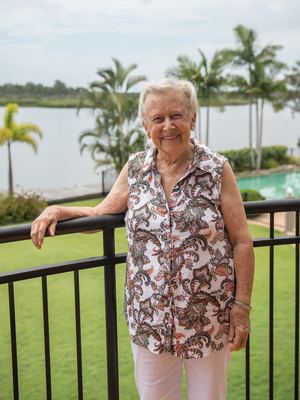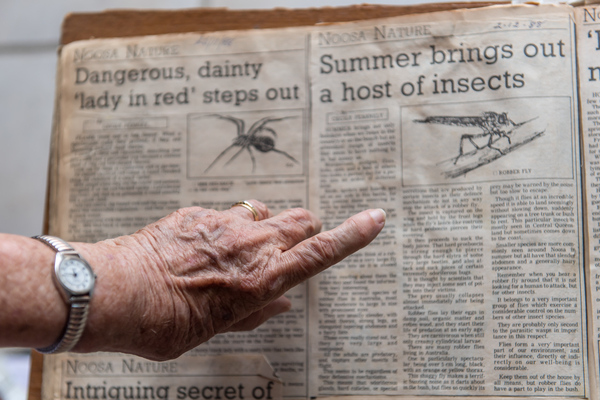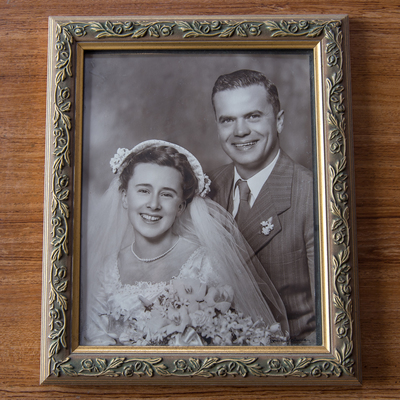By Margaret Maccoll
A good place to watch birds is how Cecily Fearnley describes her riverside unit and it’s no surprise as birds have always been one of the naturalist’s great loves.
Protecting the environment and standing up for equal rights for women have also been of immense importance to her so it is fitting that her birthday lies within the same week as International Women’s Day and World Wildlife Day. Cecily is 93 today.
Early days
Born in 1925 Cecily Sandercock finished school at Girls Grammar while World War II was raging and her brother was risking his life overseas fighting with the air force.
Instead of going to art school as expected she joined the war effort to do something “worthwhile” and used her drawing skills working for Allied intelligence based in Queen Street, Brisbane.
“I was accepted into the drafting room and interpreted maps from planes shot down so they could retrieve the bodies and take them back to America,” she said.
When the war ended and people were dancing in the streets Cecily realised her job in intelligence was finished. “I had to get a job straight away. I realised all men were coming back.”
As luck would have it she was sketching nature while on an outing to Redcliffe when a man noticed her drawing. He was the director of the Queensland Museum and was looking for an artist to draw animal specimens.
“I became the first Queensland artist at the museum. I was thrilled. I was doing what I loved. I’d always been interested in nature. I wanted to be a vet (as two of four children are) but was told that was for boys.”
Outside work Cecily was a keen bushwalker and through National Parks of Queensland met many other naturalists building on her knowledge on the topic.
After a couple of years and having saved her money she journeyed overseas and with a letter of introduction gained a job with the Royal Scottish Museum. After two winters Cecily headed back to sunny Queensland and her job was waiting for her at the Queensland Museum.
Her involvement with National Parks continued and she was among a group who set up the Brisbane Bushwalkers Club becoming its first vice-president.
It was on a bushwalkers trip that she met her future husband Jim Fearnley.
Five years later they were married and for a woman at that time it meant giving up her job.
“I had to be quite certain I’d prefer him rather than the museum for the rest of my life,” she said. “I knew he was dependable. He had high standards and was an instant leader. I was happy to give up the museum.”
Jim was a farmer and the couple moved to the farm at Upper Brookfield.
But his four years as a prisoner of war in Germany weighed heavily on him. He sometimes found the war experiences too much, Cecily said.
Jim gained comfort from the relaxed environment offered in Noosa so they bought a cottage at Little Cove immersing themselves in the love of nature they shared.
In Noosa
“Right from the start I had a knowledge of what was here,” Cecily said.
“People came from the south. They’d clear their land completely and put in plants from Victoria and wondered why they didn’t grow very well.”
Cecily said Noosa was known as a beautiful place for holiday-makers. She wanted to inform them of the beauty of the plants here.
“I appreciated the nature. I appreciated the bush and wanted to look after it,” she said.
Cecily started a bird observers group and with Dr Arthur Harold, an English doctor who settled in Noosa with his wife Marjorie in 1962, started leading people on monthly walks into the bush. “He was the botanist and I was the crazy bird person,” she said.
When plans to build a road around the Noosa Heads coastline were mooted a determined band of eco workers including Dr Harold and Cecily stood up for the environment, forming Noosa Parks Association and lobbying against the proposal.
As more people moved to the area with plans to remove the bushland and develop Jim decided the only way to make a difference was to run for council.
“He topped the polls. He was very politically minded,” she said.
When he started talking about the environment the other councillors would say ‘here we go’ but after three years he had turned them around, she said.
“Keep (the buildings) low down at tree level, keep it low key and keep the natural world around us,” was the aim for development.
“Already we’ve done so much damage to put up our houses,” she said.
While Jim used politics to protect the environment Cecily chose education.
She began writing a weekly newspaper column, Noosa Nature, accompanied by her own sketches of local fauna and flora, to raise awareness of them and the importance of their conservation.
She said loving nature and educating other people about nature had been how she had spent her life.
After 30 years and 1500 columns Cecily decided she’d had enough.
Among the many groups Cecily has been involved in over her years in Noosa have been the CWA, Noosa Arts, Penguin public speaking group and the Cooroy and district historical society.
The Noosa Bird Observers group has now been passed on to another organiser as has an extended outings group.
For her work with the environment she has been awarded a raft of awards including the Queensland Naturalist Award in 2001 and has published several popular books on the flora and fauna of Noosa and surrounding areas.
“I’ve organised people, I’ve organised places, I’ve organised things. I’ve always tried to help people to know their own ability and know they can do things,” she said.
“I’ve had a wonderful life.”
At 93 Cecily is working on writing two books and finish a number of paintings.








